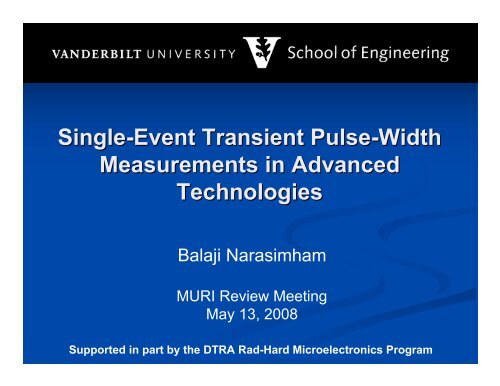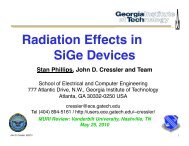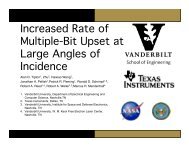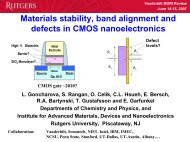Single-Event Transient Pulse-Width Measurements in Advanced ...
Single-Event Transient Pulse-Width Measurements in Advanced ...
Single-Event Transient Pulse-Width Measurements in Advanced ...
- No tags were found...
Create successful ePaper yourself
Turn your PDF publications into a flip-book with our unique Google optimized e-Paper software.
Autonomous SET captureVanderbilt Radiation Effects Group1 st stageSchool of Eng<strong>in</strong>eer<strong>in</strong>gTargetcomb<strong>in</strong>ationalcircuitLatch Latch Latch Latch LatchAutonomous orself-triggeredSET pulsemeasurementdelayCONTROL SIGNALNarasimham et al, IEEE TDMR, 2006 SET generated <strong>in</strong> custom <strong>in</strong>verter target circuitry – propagates andtriggers measurement <strong>Pulse</strong> width is proportional to number of switched states (measured <strong>in</strong>units of <strong>in</strong>verter delays) Upsets after the trigger stage are not measured Most s<strong>in</strong>gle latch upsets (due to direct strikes on the latch) are identifiableand SET width data not affectedMURI ReviewMay 13, 2008 4
Heavy-Ion – 130-nm & 90-nmVanderbilt Radiation Effects GroupSET pulse width (ps)2000180016001400120010008006004002000130-nmIBM 130-nm (8RF)9.7 9.7(60°)SET pulse width (ps)1600max140012001000 +1óavg800-1ó600m<strong>in</strong>40031.2 31.2200(50°)LET (MeV-cm0 2 /mg)58.7 58.7(38°)9.7(130-nm)130-nm90-nm9.0(90-nm)58.7(55°)1000 160090-nm1400130-nm vs 90-nm10010<strong>Event</strong>s measuredSET pulse-width (ps)31.2(130-nm)12001000800600400200030.0(90-nm)LET (MeV-cm 2 /mg)IBM 90-nm (9SF)max+1óavg-1óm<strong>in</strong>School of Eng<strong>in</strong>eer<strong>in</strong>g1.8 3 5.7 9 20.6 30 40.7 59LET (MeV-cm 2 /mg)58.7(130-nm)59.0(90-nm)10000100010010<strong>Event</strong>s measured Results <strong>in</strong>dicate <strong>in</strong>creas<strong>in</strong>g SET pulse widths with scal<strong>in</strong>g important aslatch setup/hold times decrease with scal<strong>in</strong>g more SETs latched as errorMURI ReviewMay 13, 2008 6
1.2 48 58.7 75 100Vanderbilt Radiation Effects GroupSchool of Eng<strong>in</strong>eer<strong>in</strong>g-1σ+1σ -1σ+1σSET cross section per <strong>in</strong>verter (!m 2 )100.80.60.40.20.0Cross Section Comparisonm<strong>in</strong>-1óavg+1ó100240 480 720 960 1200 1440SET pulse width (ps)9.7 MeV-cm^2/mg20 MeV-cm^2/mg58.7 MeV-cm^2/mg130-nm<strong>Event</strong>s measured10.6 30 40.7 592 /mg)maxSET cross section per <strong>in</strong>verter (!m 2 )5 MeV-cm^2/mg0.620 MeV-cm^2/mg40 MeV-cm^2/mg0.40.2010001000100<strong>Event</strong>s measured100 300 500 700 900 1100 1300SET pulse width (ps)90-nm <strong>Event</strong> cross section dom<strong>in</strong>ated by pulses between 300 ps to 700 ps <strong>in</strong> 130 nm 400 ps to 900 ps <strong>in</strong> 90 nm Increase <strong>in</strong> wider transients translates to higher error rates with scal<strong>in</strong>gMURI ReviewMay 13, 2008 7
Neutron-Induced SETsVanderbilt Radiation Effects GroupDUT boards87Neutron-<strong>in</strong>duced SETs <strong>in</strong> 90-nmSchool of Eng<strong>in</strong>eer<strong>in</strong>gneutronbeamMeasured events6543210100 300 500 700 900 1100 1300SET pulse width (ps) Tested six 90-nm ICs at WNR facility at LANL Energy spectrum matches sea-level spectrum for energies from 10 to500 MeV Neutron fluence 1.33×10 11 neutrons/cm 2 Neutron SET cross-section ~ 2.5 × 10 -6 µm 2 /<strong>in</strong>verterMURI ReviewMay 13, 2008 8
Alpha-Induced SETsVanderbilt Radiation Effects GroupSchool of Eng<strong>in</strong>eer<strong>in</strong>gMeasured events6050403020100Alpha-<strong>in</strong>duced SETs <strong>in</strong> 90-nm100 200 300 400 500 600 700 800 900 1000 1100SET pulse width (ps) Alpha tests at TIus<strong>in</strong>g foil of Am 241 Energy ~ 5.5 MeV Fluence ~ 4.45×10 10alphas/cm 2 Total eventsmeasured ~ 300 Alpha SET cross section ~ 6.74 × 10 -4 µm 2 /<strong>in</strong>verterMURI ReviewMay 13, 2008 9
Proton-Induced SETsVanderbilt Radiation Effects GroupProtons-<strong>in</strong>duced SETs <strong>in</strong> 90-nm1200School of Eng<strong>in</strong>eer<strong>in</strong>g1000maxSET pulse width (ps)800600400+1óavg-1ó200m<strong>in</strong>00 30 (WE) 60 (WE) 85 (WE) 60 (NS) Tests conducted at Indiana Univ with 200 MeV protons Proton SET cross-section ~ 2 × 10 -6 µm 2 /<strong>in</strong>verter Results <strong>in</strong>dicate that proton angle of <strong>in</strong>cidence does not affect SETwidth distributionsMURI ReviewMay 13, 2008 10
Comparison – Energetic ParticlesVanderbilt Radiation Effects Group1600Proton, Neutron, Alpha and Heavy-ion<strong>in</strong>duced SETs <strong>in</strong> 90-nmSchool of Eng<strong>in</strong>eer<strong>in</strong>g1.E+0114001.E+00SET pulse-width (ps)12001000800600400max+1óavg-1ó1.E-011.E-021.E-031.E-04<strong>Event</strong> Cross Section(!m 2 /<strong>in</strong>verter)200m<strong>in</strong>1.E-050proton200 MeVneutronspectrumalpha Ne - 3 Ar - 5.7 Kr - 20.6(5.5 MeV)(LET values)Energetic particle1.E-06MURI ReviewMay 13, 2008 11
Similarity <strong>in</strong> SET DistributionsVanderbilt Radiation Effects GroupSchool of Eng<strong>in</strong>eer<strong>in</strong>gSET pulse-width (ps)16001400120010008006004002000proton200 MeVProton, Neutron, Alpha and Heavy-ion<strong>in</strong>duced SETs <strong>in</strong> 90-nmneutronspectrummax+1óm<strong>in</strong>avg-1óalpha Ne - 3 Ar - 5.7 Kr - 20.6(5.5 MeV)(LET values)Energetic particle1.E+011.E+001.E-011.E-021.E-031.E-041.E-051.E-06<strong>Event</strong> Cross Section(!m 2 /<strong>in</strong>verter) Less variation <strong>in</strong> SET pulse widths for different particle types – probablydue to carrier redistribution and charge shar<strong>in</strong>g effects Prelim<strong>in</strong>ary simulations <strong>in</strong>dicate charge spread and diffusion collection bysubsequent gate may limit SET widthsMURI ReviewMay 13, 2008 12
Other ApplicationsVanderbilt Radiation Effects GroupSchool of Eng<strong>in</strong>eer<strong>in</strong>g Test circuit can help quantify effects of process orlayout variations on s<strong>in</strong>gle events−Circuit was used for quantify<strong>in</strong>g effect of guard bands <strong>in</strong>mitigat<strong>in</strong>g long SETs Characterization of effect of charge spread on SETwidth distributions−−Tested with ions <strong>in</strong>cident from different directions withrespect to n-well layoutInterleaved <strong>in</strong>verter cha<strong>in</strong>s have been designed to furtheranalyze charge spread effectMURI ReviewMay 13, 2008 13
Well Contacts and Guard BandsVanderbilt Radiation Effects GroupSchool of Eng<strong>in</strong>eer<strong>in</strong>gWell Contacts(isolated)HDWCHDWCGBsubstratecontactConventional Layout –Isolated Well ContactsHigh Density WellContacts (HDWC)HDWC + Guard Band (GB) Strikes with<strong>in</strong> n-well lead to long SETs dueto parasitic bipolar effect Mixed mode simulations us<strong>in</strong>g calibrated130-nm process – show effect of GB andHDWC <strong>in</strong> mitigat<strong>in</strong>g long SETsMURI ReviewVoltage (V)1.41.210.80.60.40.20-0.2isolated contactsHDWCHDWC+GBmixed mode TCAD simulationLET = 40 MeV-cm 2 /mg0.0E+00 5.0E-10 1.0E-09 1.5E-09 2.0E-09 2.5E-09 3.0E-09time (s)May 13, 2008 14
Characteriz<strong>in</strong>g Guard BandsVanderbilt Radiation Effects GroupXe at 38.5 deg<strong>Event</strong>s measured60504030201002403604806007208409601080SET pulse width (ps)with GB+HDWCwith isolated contacts1200132014401560Cumulative <strong>Event</strong> Cross Section (cm 2 )1.E-051.E-061.E-07School of Eng<strong>in</strong>eer<strong>in</strong>gSETs > 1 ns - with isolated contactsSETs > 1 ns - with GB + HDWC1.E-080 20 40 60 80 100 120Effective LET (MeV-cm 2 /mg)isolated contacts –conventional layoutpracticehigh density wellcontacts (HDWC)guard bands (GB) <strong>Event</strong>s > 1ns reduced by ~72% forcircuits with GB + HDWC Reduction <strong>in</strong> frequency and max SETwidth attributed to reduction <strong>in</strong>parasitic bipolar effectMURI ReviewMay 13, 2008 15
ImpactVanderbilt Radiation Effects GroupSchool of Eng<strong>in</strong>eer<strong>in</strong>g Resolve controversy on expected pulse widths Quantify technology trends <strong>in</strong> SET pulse widths Characterize effect of RHBD structures such as multiplewell contacts and guard bands on SET pulse widths Determ<strong>in</strong>e effect of charge shar<strong>in</strong>g on SETs Technique can also be used to measure other spurioussignals such as cross-talk pulsesMURI ReviewMay 13, 2008 16
ConclusionVanderbilt Radiation Effects GroupSchool of Eng<strong>in</strong>eer<strong>in</strong>g Autonomous SET characterization technique developedand implemented to obta<strong>in</strong> precise distributions ofheavy-ion, neutron, proton and alpha <strong>in</strong>duced SETwidths <strong>in</strong> 130-nm/90-nm CMOS <strong>Width</strong> and range of dom<strong>in</strong>ant SETs <strong>in</strong>crease with scal<strong>in</strong>g Neutron and alpha particle <strong>in</strong>duced SETs are of order oflegitimate logic signals – concern for commercialapplications High density well contacts and guard bands helpsreduce more than 70% of SETs longer than 1 nsMURI ReviewMay 13, 2008 17





